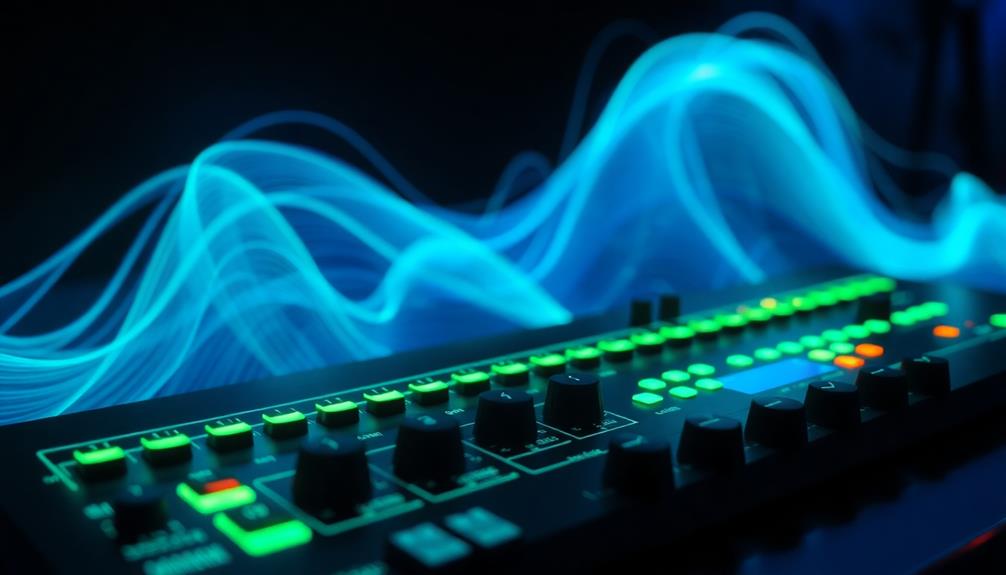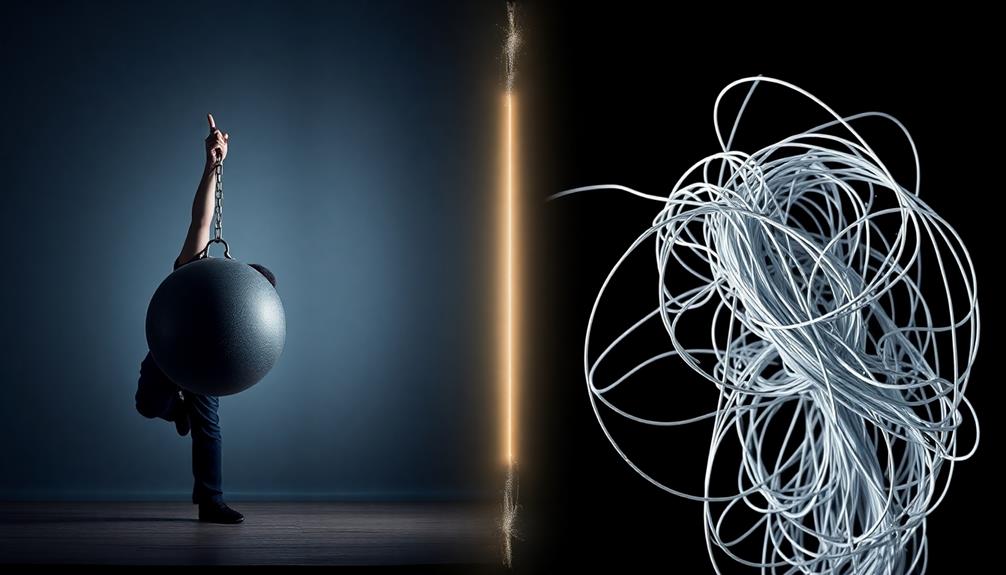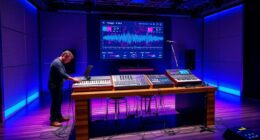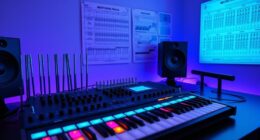You can truly elevate your drum programming game by mastering essential techniques that make your beats hit hard every time. Start by layering kick and snare sounds to create a powerful punch, and apply dynamic velocity for that human feel. Experiment with unique percussion elements and genre-specific patterns to keep things fresh. Don't forget about the mixing; proper EQ and compression can really enhance clarity and impact. With the right electronic drum plugins, the possibilities are endless. There's so much more you can explore to transform your beats into unforgettable tracks.
Key Takeaways
- Utilize step sequencing for precise control of intricate drum patterns, enhancing rhythmic complexity.
- Layer kick and snare samples to create a fuller, more impactful sound in your beats.
- Add dynamic velocity variations to drum hits for a human feel, engaging listeners more effectively.
- Incorporate unique percussion elements and unconventional sounds to enrich your drum patterns and stimulate creativity.
- Master mixing techniques, including EQ and compression, to achieve a polished and professional drum sound.
Overview of Beatmaking Today
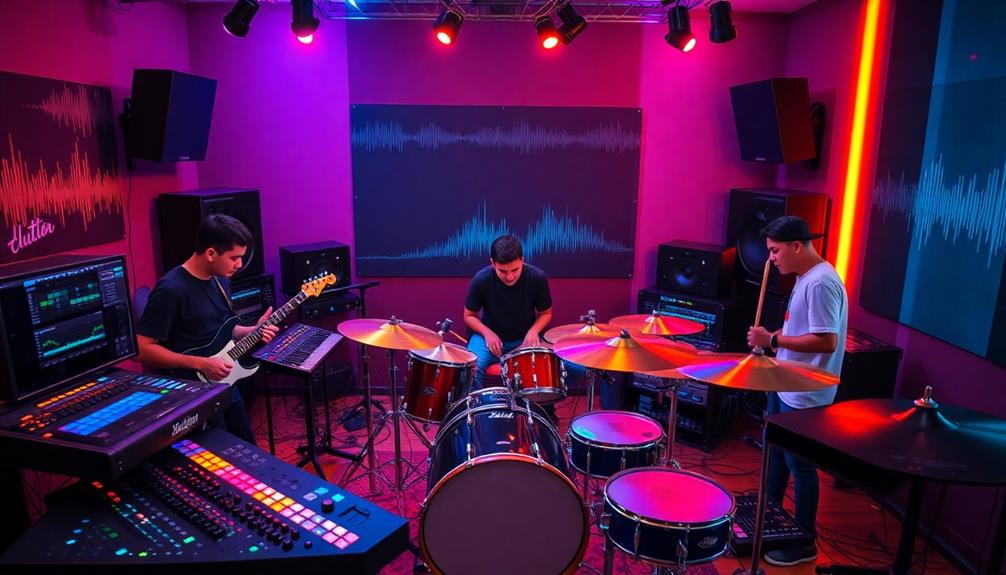
Beatmaking today is more accessible and exciting than ever before. You've got advanced digital audio workstations (DAWs) at your fingertips, allowing you to dive deep into intricate drum programming and mixing without needing a live drummer.
Modern drum machines have evolved considerably, offering features that let you blend acoustic and electronic drum sounds seamlessly. Whether you're crafting a punchy kick drum or experimenting with complex drum patterns, the tools available today empower you to innovate.
With the rise of AI technologies, beat making has entered a new domain, enabling you to create more intricate and innovative rhythms. Step sequencing remains a key technique, giving you precise control over your drum patterns and rhythms—an approach that echoes the workflows established by early drum machines.
Plus, the availability of high-quality, affordable electronic drum plugins has democratized access to professional drum sounds, inviting aspiring producers like you to explore and develop your skills across various genres.
In this vibrant landscape of music production, the possibilities are endless, and every beat you create can resonate with your unique artistic vision.
The Evolution of Drum Machines
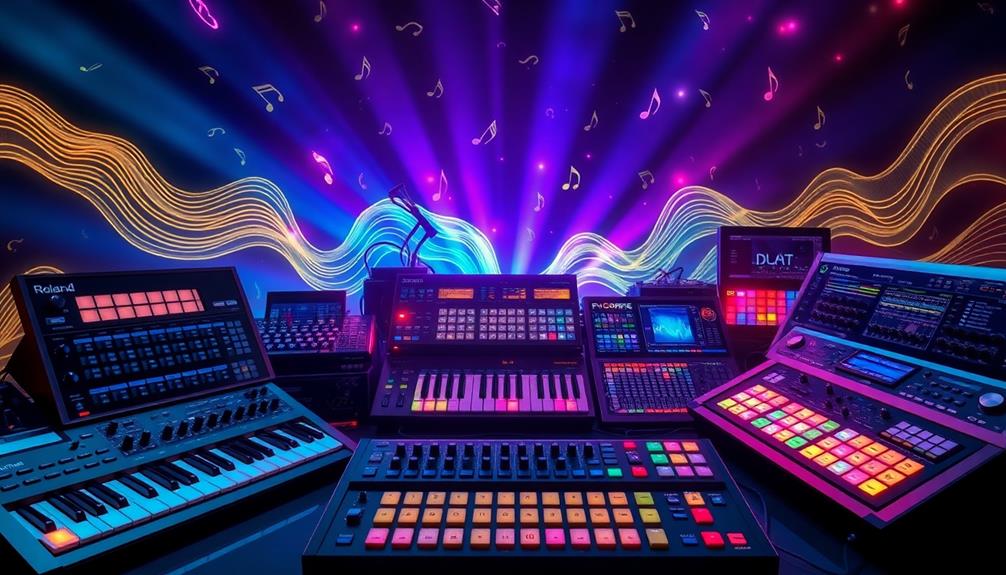
The evolution of drum machines has transformed the landscape of music production since the 1970s. Early models like the Roland TR-77 and CR-78 laid the groundwork for electronic percussion. Then, the iconic Roland TR-808 emerged in 1980, becoming essential for hip-hop and dance music, thanks to its deep bass drum sound. The introduction of the TR-909 in 1983 combined analog and digital sounds, greatly shaping genres like techno and house.
By the 1980s, advancements in sampling technology allowed drum machines to include real drum sounds, elevating their versatility and creativity. Today, you can seamlessly integrate these sounds in modern digital audio workstations (DAWs), making beat crafting more intuitive than ever.
| Drum Machine | Release Year |
|---|---|
| Roland TR-77 | 1977 |
| Roland TR-808 | 1980 |
| Roland TR-909 | 1983 |
| Modern DAWs | 2000s |
As you explore the history of these machines, you'll appreciate how they've shaped the beats and rhythms that resonate in today's music. Embracing this evolution can inspire your drum programming journey.
Essential Drum Programming Techniques
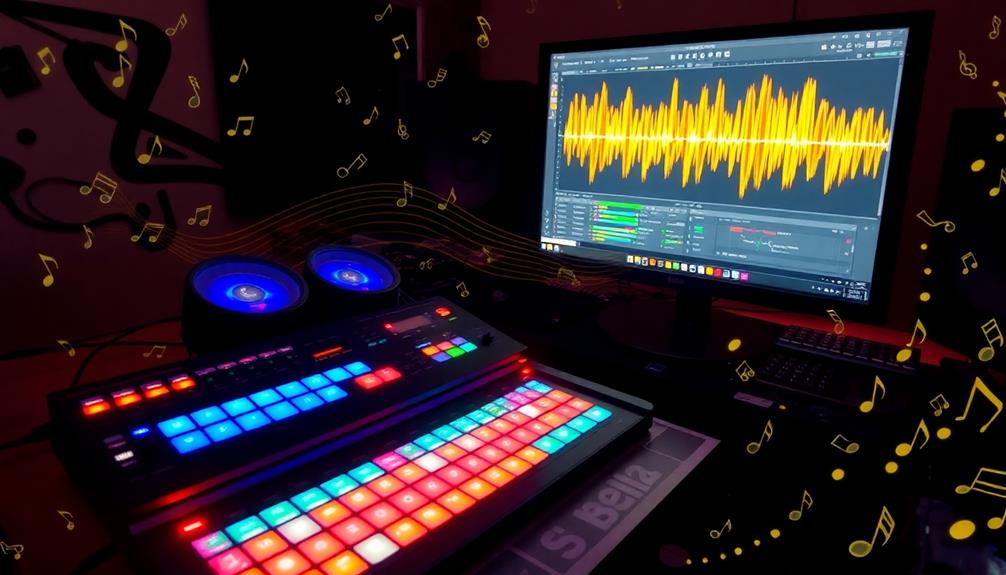
Drum programming opens up a world of creativity and precision in music production. To craft beats that truly resonate, start by utilizing step sequencing to create intricate drum patterns. This method gives you precise control over timing and allows for effective layering techniques, much like the classic Roland TR-808.
Familiarity with essential skills for QA testers can enhance your approach to music production by emphasizing attention to detail.
Experiment with dynamic velocity by varying the intensity of your hits. This adds a human feel to your beats, making them more engaging for the listener. Don't shy away from kick and snare layering; combine different kick samples and snare sounds for a richer, more impactful mix.
Incorporate fills and rolls strategically, using tom fills to create smooth shifts and build anticipation within your tracks. This keeps your audience on their toes.
Lastly, balance repetition and variation in your drum patterns. Consistent elements provide familiarity, while occasional changes keep the energy alive and maintain listener interest.
Top Electronic Drum Plugins
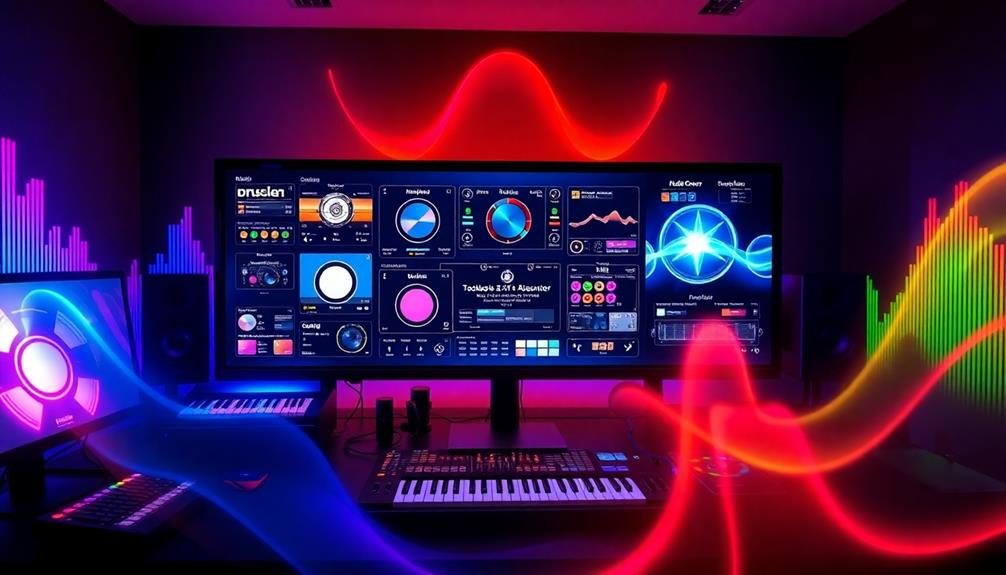
When diving into electronic music production, choosing the right drum plugin can make all the difference in crafting the perfect beat.
You'll want to explore options like Wave Alchemy Triaz, which offers an extensive library of electronic drum sounds for intricate beat-making. If you're after classic sounds, UVI BeatBox Anthology 2 features iconic drum machine samples and vintage options, ideal for replicating those timeless beats.
Native Instruments Battery 4 is another excellent choice, allowing you to layer different drum samples and customize your kits for unique sonic results.
For those who love the nostalgia of classic Roland sounds, D16 Group's recreation plugins deliver authentic emulations with powerful sound design tools suited for contemporary production.
Mixing Techniques for Drum Tracks
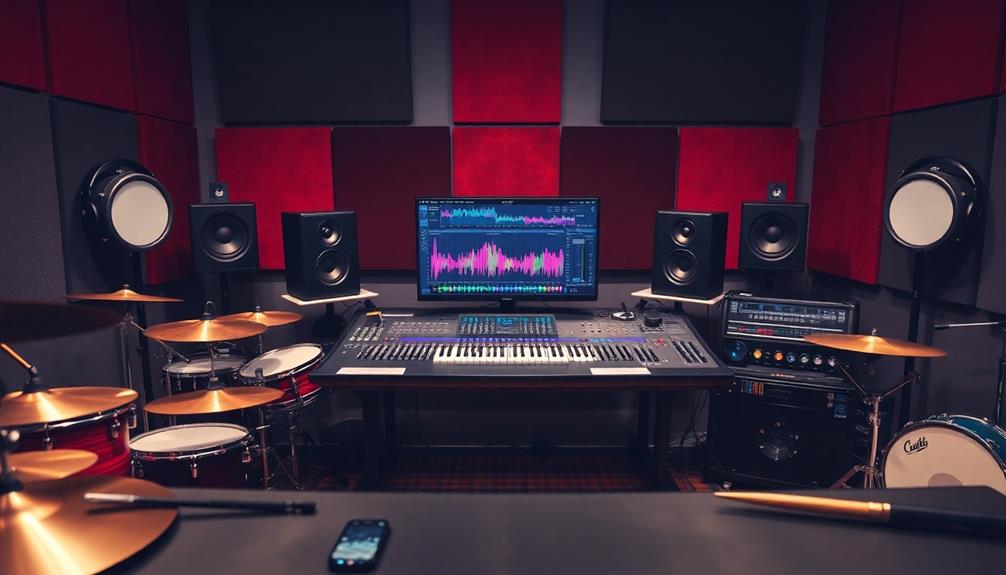
Properly mixing drum tracks is essential for achieving a polished sound that drives your music forward. Start by applying effective mixing techniques to each element of your drum kit.
For your kick pattern, make EQ adjustments by boosting low frequencies around 60-100 Hz for punch while cutting muddiness in the 200-400 Hz range. This helps your kick stand out in the mix.
Next, employ compression on your kick and snare tracks. Aim for a ratio of 4:1, adjusting the attack and release times to enhance the punchiness of each hit. This control over dynamics guarantees your drums hit hard without losing energy.
For the snare, introduce subtle reverb to add depth and space, but don't overdo it; you want to maintain clarity.
Understanding Groove and Swing

After you've fine-tuned your drum tracks, the next step is to focus on the groove and swing that will bring your beat to life. Groove refers to the feel and rhythmic flow of your beats, and you can enhance it by varying the timing and placement of notes, especially in hi-hats and snares. This subtle manipulation creates a more dynamic sound that resonates with listeners.
Swing, on the other hand, introduces a shuffle feel by delaying the timing of certain notes. This technique breathes life into your rhythms, making them feel more engaging compared to straight beats. You can adjust the amount of swing to achieve different effects—light swing adds subtle movement, while heavy swing offers a pronounced, bouncy quality.
To enhance jazz-inspired beats, consider applying moderate swing on ride cymbals and snares. This approach lends an organic quality to your electronic music.
Don't shy away from experimenting with groove and swing percentages; doing so can yield unique and rhythmic results, making your drum patterns feel alive and enthralling. Embrace these elements to elevate your beats!
Layering Drums for Impact

When you layer your kick and snare, you're not just adding sounds; you're crafting a more powerful foundation for your beats.
Incorporating unique percussion elements can further enrich your drum patterns and create a distinctive vibe.
Kick and Snare Layering
Kick and snare layering is essential for crafting a punchy and engaging drum sound in your productions. By layering different kick samples, like a deep bass kick with a punchy clicky kick, you can create a fuller low-end presence that really hits hard.
When it comes to snares, combine your primary snare with elements like claps or rim shots to enhance brightness and create a more impactful backbeat.
Don't forget about EQ! Carve out space in the frequency spectrum for each layer. For example, low-cut the higher snare layer to prevent muddiness, while boosting the fundamental frequencies of your base snare. This helps maintain clarity in your drum hits.
Experimenting with different velocities and articulations for each layer adds dynamic interest, making your drum patterns feel alive and engaging.
Transient shaping tools can also make a huge difference; they enhance the initial attack of your layered kicks and snares, ensuring they cut through the mix effectively.
With these techniques, you'll elevate your drum programming game and create beats that resonate with energy and impact! By focusing on dynamic variation and groove, your tracks will become more engaging and memorable. Exploring advanced MIDI programming techniques for producers, such as humanizing sequences or layering percussive elements, can add depth and complexity to your beats. The key is to experiment fearlessly and let your creativity shape the rhythm.
Unique Percussion Elements
Incorporating unique percussion elements into your drum programming can transform an ordinary beat into something truly special. By layering different sounds, you can create a richer texture that stands out. Consider blending acoustic and electronic elements for added variety in your drum production.
| Layering Technique | Purpose |
|---|---|
| Kick Samples | Creates impactful low-end |
| Snare with Claps | Enhances brightness and texture |
| Hybrid Kits | Adds versatility and richness |
| Unique Percussion | Elevates overall sound |
Using deep and punchy kick samples together can fill out your low-end presence, while snares combined with claps or rim shots brighten your mix. Don't forget to experiment with unique percussion instruments like shakers or tambourines. These elements provide distinctive textures that elevate your track.
Balancing volume and panning among these layers keeps your beats dynamic and engaging. Each unique percussion element should contribute effectively, ensuring your listeners feel the impact of every beat. So, get creative and explore the possibilities—your beats will thank you for it!
Genre-Specific Beat Patterns

Understanding genre-specific beat patterns is essential for creating compelling drum tracks that resonate with listeners. Each genre has its unique rhythms, and mastering these can elevate your drum programming.
- House Music: Operates at around 130 bpm, featuring a kick always on every beat. This creates a driving, danceable rhythm perfect for clubs.
- Trance: With a faster tempo of about 140 bpm, trance emphasizes manic hi-hat patterns that build tension and induce euphoria through melodic progressions.
- Hip Hop: Typically, you'll place kicks on the 1st and 3rd beats, with snares on the 2nd and 4th. This laid-back yet punchy groove supports vocal delivery effectively.
Incorporating intricate hi-hat patterns and syncopated rhythms is vital for genres like Dubstep, while Drum & Bass operates at a rapid 160-170 bpm, showcasing frantic hi-hats and heavy bass lines that drive high energy.
Experimenting with these beat patterns not only enhances your drum loops but also helps you create sounds that truly capture the essence of each genre.
Get to know these patterns, and watch your tracks come to life!
Adding Human Feel to Beats
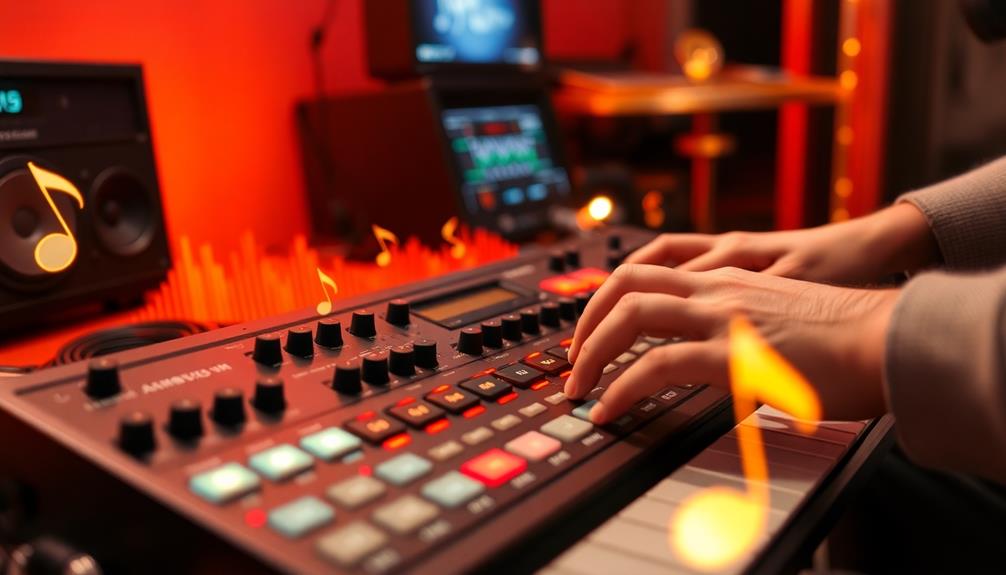
Adding a human feel to your beats can transform a rigid drum pattern into something that breathes and resonates with listeners. One way to do this is by switching off quantization and introducing slight timing shifts in kick and snare placements, creating an organic rhythm. Varying the velocities of hits, particularly on hi-hats and snares, replicates the dynamics of a real drummer and enhances expressiveness.
Incorporating ghost notes—soft, unaccented hits—between main drum hits adds depth, mimicking the subtle nuances of live playing. Adjusting hi-hat positions slightly off the grid and introducing subtle delays can create a swing feel that enhances groove and liveliness in your track.
Here's a quick reference to help you remember these techniques:
| Technique | Description |
|---|---|
| Timing Shifts | Shift kick and snare slightly off the beat |
| Velocity Variation | Change velocities on hi-hats and snares |
| Ghost Notes | Add soft hits between main drum hits |
| Hi-Hat Articulation | Use rim shots or different hi-hat positions |
Experiment with these elements to breathe life into your beats and achieve that sought-after human feel!
Future Trends in Beatmaking
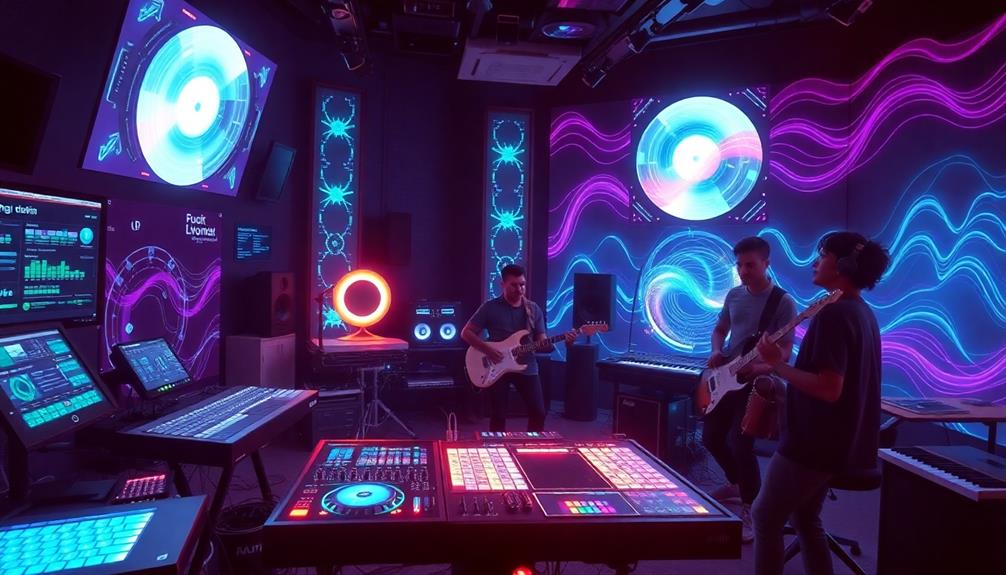
As technology evolves, beatmaking is transforming in exciting ways. You'll find that the integration of AI technologies streamlines your creative process, making it easier to generate unique drum patterns and sounds.
With advancements in processing power, your future beatmaking tools will allow for complex drum programming and intricate sound manipulation that will elevate your music.
Consider these trends as you immerse yourself in beatmaking:
- Blending electronic sounds with acoustic drums to create innovative beats.
- Utilizing user-friendly software that makes high-quality production accessible.
- Keeping up with continuous updates and new plugins to enhance your techniques.
These developments encourage you to explore unconventional instruments and sample different sounds, pushing the boundaries of making music.
As you experiment with sampled drums and electronic elements, you'll discover fresh ways to make your tracks stand out.
Embrace the blending of genres and the accessibility of modern tools, and you'll be well on your way to crafting beats that resonate.
Frequently Asked Questions
What Is the Hardest Drum Beat to Play?
When you tackle the hardest drum beat, you might struggle with advanced polyrhythms or intricate patterns like the paradiddle diddle. Double bass techniques and odd time signatures can also push your skills to the limit.
What Is the Most Sampled Drum Beat of All Time?
You might recall that iconic six-second rhythm from countless tracks; it's the "Amen Break." This legendary beat's been sampled over 2,000 times, embedding itself deeply into various genres and shaping modern music culture.
How to Make Trap Drums Hit Harder?
To make your trap drums hit harder, use high-quality samples, set your BPM between 140-160, apply sidechain compression, vary hi-hat patterns, and enhance transients on your kicks and snares for maximum impact.
How Do You Make Drums Hit Harder Logic?
Did you know that well-mixed drums can increase listener engagement by over 50%? To make your drums hit harder in Logic, layer sounds, adjust velocities, use compression, and apply EQ to enhance their impact.
Conclusion
In the world of beatmaking, you've got the power to create sonic masterpieces that'll blow minds and shake dance floors! By mastering drum programming, you're not just making music; you're crafting unforgettable experiences that'll echo in hearts for ages. So, immerse yourself in those techniques, release your creativity, and watch as your beats transform into pure magic! Trust us, with the right skills, you're destined to become the next beat-making legend, ruling the soundscape like a musical deity!


